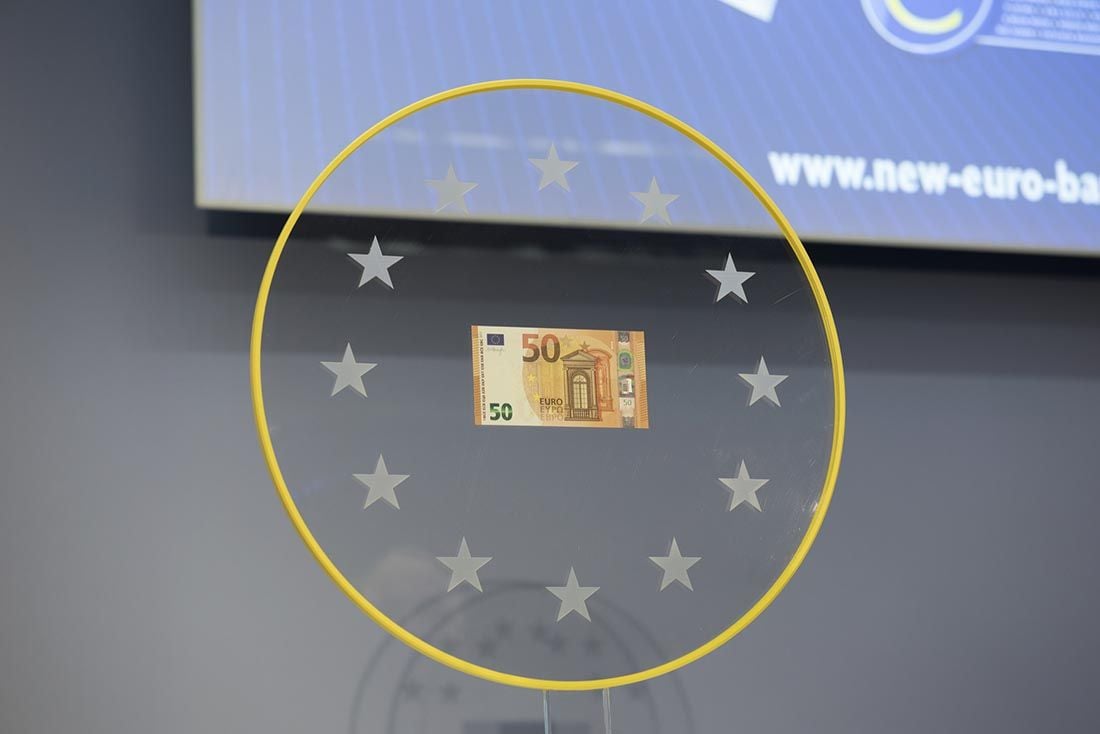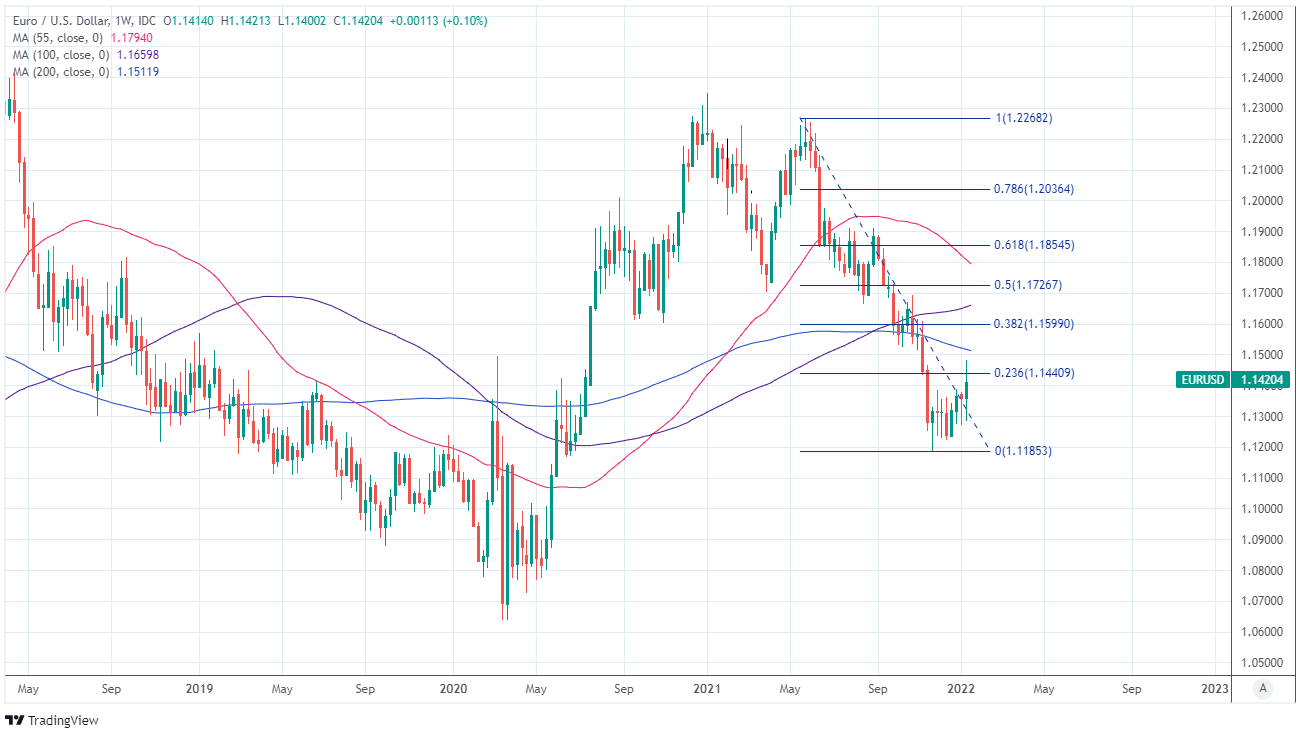Euro / Dollar Week Ahead Forecast: Dip Buyers Could be Drawn Below 1.14
- Written by: James Skinner
-
- EUR/USD could draw dip buyers near 1.1380
- As technical bottom appears to form on charts
- But market appetite for USD key to recovery

Image © European Central Bank
The Euro to Dollar rate rallied swiftly to two-month highs last week, leaving the impression of a bullish turn behind in its wake on the charts, and price action this week may be likely to reveal whether a turning point has been reached by the single currency.
The Euro entered the new week trading comfortably above 1.1400 after rallying to almost 1.15 last Wednesday and Thursday in price action that helped to make it the second best performing major currency of 2022.
“Traders may try to buy a pullback to 1.1380. The bottom pattern remains while above the rising black trend line now at 1.1280. Should the euro break below this, it will appear bearish,” said Paul Ciana, chief technical strategist at BofA Global Research, in a Friday research briefing.
Last week’s rally has cultivated the appearance of a bottom beginning to form on the charts and prompted technical strategists at BofA Global Research to suggest the Euro may be likely to draw dip buyers in the event of any renewed weakness over the coming days.
Much about the short-term outlook for the Euro depends, however, on the market’s appetite for the Dollar given that many analysts saw it as being lifted by widespread declines in U.S. exchange rates last week rather than any renaissance for the European currency.
Above: EUR/USD shown at daily intervals with Fibonacci retracements of December rebound indicating possible areas of technical support.
- EUR/USD reference rates at publication:
Spot: 1.1425 - High street bank rates (indicative band): 1.1025-1.1105
- Payment specialist rates (indicative band): 1.1322-1.1368
- Find out more about market-beating rates and service, here
- Set up an exchange rate alert, here
“There has been little net change in direction along the G10 (non-USD) EUR cross rates; the NOK, AUD, NZD, SEK, CAD, and GBP are all holding their gains vs the EUR since the end of last week, further highlighting that the defining aspect of the rally in EURUSD is broad USD weakness,” says Stephen Gallo, European head of FX strategy at BMO Capital Markets.
Dollar exchange rates fell broadly from last Tuesday with the sell-off accelerating in the wake of congressional testimony from Federal Reserve Chairman Jerome Powell and official figures confirming that U.S. inflation reached a multi-decade high of 7% in December.
Many analysts have suggested the Dollar’s declines likely reflect profit-taking by speculative traders who’d bid the currency higher over a six month period heading into the new year only to see its momentum waning during the one month to mid-January.
“We would still argue positioning and the technical break in EUR/USD at around 1.1440 have played the key role in EUR demand but real money fixed income flows could be reinforcing that demand,” says Lee Hardman, a currency analyst at MUFG, writing in a Friday research note.
{wbamp-hide start} {wbamp-hide end}{wbamp-show start}{wbamp-show end}
While the Dollar’s declines were a big driver of the single currency last week, BMO Capital Markets and some other firms have suggested there could be central bank interest in the Euro that may also have helped it to rally.
“We're of the view that flows through the FX market have won out over fundamentals, and still believe interest to fade EUR strength on the non-USD crosses will indirectly cap topside advancement in EURUSD (though that is not the only factor we think will contribute to EURUSD restraint),” Gallo and colleagues cautioned in a market commentary last Thursday.
While the market’s appetite for the Dollar will likely be an ongoing influence, the Euro could also potentially benefit this week from Monday’s surprise interest rate cut in China, which is supportive of growth in Europe’s largest trade partner economy.
“A continued drive through 1.15 in the days ahead may be necessary to place more confidence in the EUR’s recent run. On the flip side, the EUR’s decline since the day’s high has found support in the mid-figure zone where it closed last night, while ~1.1435 may act to prevent a further slide toward the 1.14 support area,” says Juan Manuel Herrera, a strategist at Scotiabank.
Above: EUR/USD shown at weekly intervals with selected moving-averages and Fibonacci retracements of June 2021 decline indicating possible areas of technical resistance to any further recovery.
Secure a retail exchange rate that is between 3-5% stronger than offered by leading banks, learn more.
While it remains to be seen if the Euro-Dollar rate can hold onto its recent gains through the week ahead, the single currency could be in line to benefit during the months ahead if it transpires that the policy stance of the European Central Bank (ECB) is beginning to shift in a less ‘dovish’ direction.
With a rising risk of inflation remaining above the bank’s target for longer than has so far been expected, some of the ECB’s policymakers have indicated recently that a further change in Frankfurt’s monetary policy settings cannot be as readily ruled out for the year ahead as it was in 2021.
“We expect the drivers of inflation to ease over the course of this year. But we understand that rising prices are a concern for many people, and we take that concern very seriously. So let me reiterate that our commitment to price stability remains unwavering. We will take any measures necessary to ensure that we deliver on our inflation target of 2% over the medium term,” ECB President Christine Lagarde said last Friday.
The ECB has so far insisted there’s almost no chance of an interest rate rise in the Eurozone this year or next due to its expectation that recently elevated inflation pressures would subside of their own accord over the course of 2022, although with inflation reaching another record high in December, there’s a chance that this stance could change over the coming months.
“This is in line with our own view that advanced economies may have entered a new inflation era within the inflation targeting regime, where disinflationary pressures are less than during the 2010s. And given the persistent weakness of inflation in that period, higher inflation would not be a bad thing,” says Tim Hunter, an economist at Oxford Economics.
The Eurozone economic calendar is devoid of major appointments for the single currency this week, although the market could look closely at Thursday’s final estimate of inflation for the month of December after Eurostat said last month the annual rate likely reached 5% by year-end.






